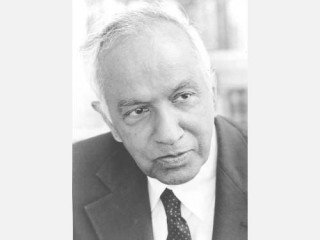
Subrahamanyan Chandrasekhar biography
Date of birth : 1910-10-10
Date of death : 1995-08-21
Birthplace : Lahore, Punjab, British India
Nationality : Hindi
Category : Science and Technology
Last modified : 2010-06-22
Credited as : Astrophysicist, ,
0 votes so far
The boyish-looking teacher was Subrahamanyan Chandrasekhar, one of the world’s leading astrophysicists. Besides making significant contributions to the study of the stars, he has written books that are recognized as classics. He also won the Noble prize in physics in 1983.
S. Chandrasekhar was born on October 10, 1910, in Lahore, now in Pakistan. He had his basic education in Madras. From childhood he was fond of reading. While most of his classmates never read books outside the syllabus, he visited the library regularly and read every new book in physics, even research journals.
Those were the 1920’s when modern physics was taking birth. There was a flood of new, exciting discoveries. In particular books of such great scientists as Arnold Sommerfield and Arthur Compton drew Chandrasekhar to modern physics. And before he was 18 his research papers appeared in the Indian Journal of Physics.
By the time he did his B.A. (Hons) at the Presidency College in Madras, he had many papers to his credit. One of them even appeared in the proceedings of the Royal Society, a rare honour for one so young. In due course, he went Cambridge as Fellow of Trinity College.
At the age of 27, Chandrasekhar’s reputation as a promising astrophysicist had been established. When he reached the USA in 1937, the eminent astronomer and Director of Yerkes Observatory, Otto Struve, recognized his genius and offered him a job at the University of Chicago.
In the world of astrophysics Chandrasekhar is best known for “Chandrasekhar’s limit”. This imposes a restrictions on the size of a highly dense variety of star known as the White Dwarf. If this type of star has mass in excess of the limit, it explodes like thousands of nuclear bombs ignited together to become a very bright star, called Supernova, until all the excess matter is shed into space. Although Chandrasekhar calculated his “limit” purely on mathematical equations, astronomers have found that all the White Dwarf stars in the sky have masses within his prescribed limit.
As early as 1935 he had come close to speculating on the formation of “black holes”, super heavy heavenly objects, a spoonful of which weights several thousands of tons. But contemporary astronomers were not prepared to accept that intriguing speculation.
Chandrasekhar has also made significant contributions to understanding the atmosphere of stars and the way matter and motion are distributed among the stars in a galaxy. His work on rotating fluid masses and the blueness of the sky is also well known. Today, at the late age of 75 when most scientists retire, Chandrasekhar continues to study the effect of gravity and electromagnetic fields on rotating black holes.
Recipient of many medals and honours, Chandrasekhar is at once a physicist, an astrophysicist and an applied mathematician. Every decade or so he changes his field of study. He studies a new subject from scratch, masters it and makes significant contributions to it.
“Great men are seldom born,” Chandrasekhar warns young boys and girls. “All great men are self-made”.
Though he has lived in the USA since 1937, a visitor to his house might well find him wearing the south Indian dhoti and listening to Carnatic music.
















